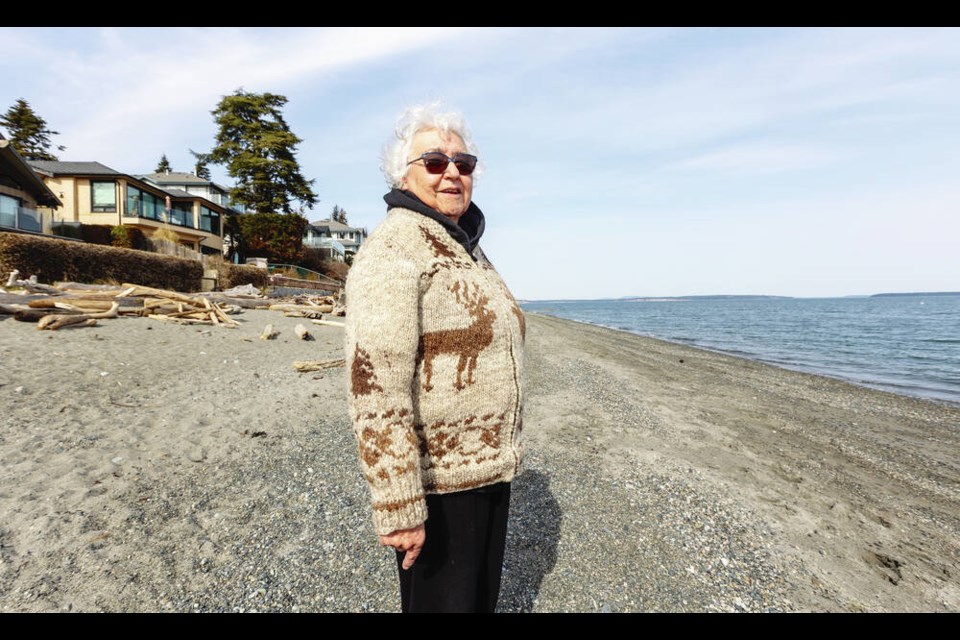The W̱SÁNEĆ people have an ancient story about a young man who wanted a giant to teach him a powerful song.
OK, the giant said, I’ll teach it to you as long as you agree not to share it with anyone.
Alas, the young man couldn’t help himself. As he and his wife paddled back from Point Roberts, where the giant lived, to their home in ȾEL¸IȽĆE, a village on the eastern side of the Saanich Peninsula, he burst into song. The giant knew immediately that the promise had been broken, so hurled a boulder that turned the young couple into a Cordova Bay rock that subsequent generations could point to by name, NOU¸NEĆ.
Brian Thom, an associate professor of anthropology at the University of Victoria, tells this story while standing in ȾEL¸IȽĆE — or, as you are more likely to know it, Agate Lane Park, a postage stamp of grass leading to the beach at Cordova Bay.
As a living, breathing village, ȾEL¸IȽĆE (rough pronunciation: Tel-eech) ceased to exist long ago. Records indicate no one lived there full time after the 1860s, though elders say house posts could be found there as late as 1913.
There’s nothing visible now but the modern homes that began lining the waterfront after the Second World War.
Underground, though, it’s a different question. Below the surface, there are at least 1,000 years of village history to untangle, of clues to a past that has modern-day implications.
That’s why Thom and the Tsawout First Nation’s Mavis Underwood, among others, were so excited this past week to talk about a joint Tsawout/UVic field school that will delve into the village and its surrounding area this summer. They have permits to explore Saanich’s four municipally owned properties on Cordova Bay, plus a long stretch of beach below the high-tide mark.
Work will begin in May when a team from Washington State University uses ground-penetrating radar to map the site, figuring out which spots merit investigation and which, primarily possible burial sites, should best be avoided.
Archeologists, UVic students and Indigenous youth will take advantage of early July’s low tides to poke into the intertidal zone — looking for evidence of fish traps, sea gardens that sort of thing — before turning their attention to the four municipal sites: Agate Lane Park, McMorran Park, Cordova Bay Park and a narrow sliver of land at the end of Waters Edge Road.
Physical evidence of the archeological work will largely be limited to Agate Lane Park, the only location people can expect the classical scene of students sifting soil in perfectly square holes.
Thom is keen to see how the findings relate to the Douglas Treaties. Under the terms of the south Saanich treaty of 1852, should a reserve have been carved out at ȾEL¸IȽĆE as was done at other Peninsula villages? What about the right to hunt and fish in the area? And how does that tie into a modern context and today’s reconciliation efforts?
Both Thom and Underwood stress the value of connecting local Indigenous kids with a severed past.
“It instils a sense of pride,” Underwood says. “That’s what’s really important to the young people, to know they have a sense of belonging here, they have a history here.”
That’s strengthened, she says, when they become part of that history, part of the chain.
“I come from a family of 15, and my dad sustained us by crabbing,” says Underwood, 69. Her father also caught salmon, snared rabbits and birds, and harvested seagull eggs from nearby islands. That sort of knowledge was passed down generation to generation, tying present to past.
There has never been a systematic archeological exploration of ȾEL¸IȽĆE, though some of its history is known. In 1792, a longboat from a Spanish ship anchored at Esquimalt poked into Cordova Bay, only to be chased away by canoes from the area. “They had a violent encounter in the bay,” Thom says.
Evidence of the past was also dug up — literally — as the community of Cordova Bay grew. Victoria Times and Daily Colonist stories from the 1940s through ’60s document the kind of casual burial-ground disturbance that makes anthropologists cringe. “Alas, poor Yorick,” wisecracked a Hamlet-loving Colonist caption writer under a photo of a couple of centuries-old skulls unearthed during construction. There was no indication that anyone thought the discoveries should affect development, or that they were anything but relics of a long-vanished world.
“They dealt with us as though we were dead,” Underwood says. “We’re not dead. Our history isn’t over.”
Both Underwood and Thom — noting the discovery of ancestral remains during Cordova Bay Road construction project in 2021 — want greater protection for such sites. “We shouldn’t be desecrating Indigenous graves any more,” Thom says.
The thing is, how do you know where the areas of historical significance are? The Archeology Branch lists 19 sites around Cordova Bay, but logic says that with so little mapping done, it wouldn’t take much to stumble upon more. An archeological study paid for by a homeowner near Agate Lane Park in 2008 revealed about 350 artefacts, several burial sites and a cache of animal bones used for weaving. Imagine what lies under other properties.
It’s the sort of prospect that makes homeowners squirm, as they are on the hook for the cost of archeological work and could see development plans go sideways if evidence of the past is found when they dig into their land. The law does not encourage property owners to be honest about what the backhoes turn up.
That inherent conflict has to change if the needs of both the current property owners and the historic, but still present, residents of the land are to be met.
The latter haven’t gone anywhere, Thom says. “This is still their landscape, so let’s do what we can to make this a welcoming place again.”
>>> To comment on this article, write a letter to the editor: [email protected]



